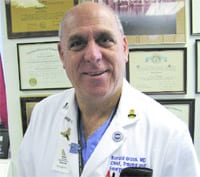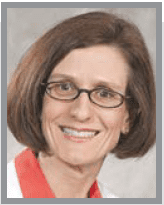Trauma Surgeon’s Job Description: ‘I’m Making a Difference’
Dr. Ronald Gross remembers feeling on the verge of vomiting.
He had just been stat-paged (code in this business for ‘get there immediately’) to the emergency department at Norwalk (Conn.) Hospital. Upon arrival, he saw a young child being wheeled in that appeared to be of the same age and size as his son.
“I thought that’s why they stat-paged me — it was my kid,” he told The Healthcare News while detailing the feeling of nauseousness that came over him at that moment. He quickly learned that this was not his child, but rather a 3-year-old girl, struck by a garbage truck, who was fighting for her life and seemingly losing the battle.
“She came out from behind a rock wall and the truck driver never saw her; she was hit hard by the bumper,” he explained. “She had shattered her liver from the impact and had virtually no blood pressure when I first saw her.
“I rushed her up to the operating room and took care of her; I had to take out half of her liver,” he continued. “I spent the next five days at the hospital by her bedside on a fold-out chair, not wanting to leave her side because I didn’t know what was coming next.
“I got a thank-you note from her parents and followed her progress for a few years,” he went on, fast-forwarding through the child’s eventual recovery. “Every Christmas I would get a card from her mother wishing me happy holidays. Then one year I got a picture of this little girl, who was now 18 years old and a clothing model for one of the major department stores in New York. And I thought to myself, ‘wow, you made a difference.’”
It was with that last phrase, one he would use early and often as he talked with The Healthcare News, that Gross, chief of Trauma and Emergency Surgery Services at Baystate Medical Center, neatly summed up what he enjoys most about his profession.
“I’m involved in a life at what most times is the worst possible occasion in a person’s lifetime, and, more often than not, I’m actually able to do something to help,” he said. “And it’s immediate; it’s not wating six months to see if someone was able to quit smoking. It’s immediate, I did something today to make a difference in someone’s life.”
Gross, who said that every emergency room physician has countless stories similar to one about the little girl with the shattered liver, but, sadly, an equal number where the outcome wasn’t good, noted that this ability to make a difference takes a number of forms in his specialty.
Savings lives in the operating room is the most obvious, he said, but there is another, equally important part of the equation, that of prevention.
He said that he and others in this profession spend a great deal of time giving lectures, leading prevention programs, and lobbying lawmakers for legislation on matters ranging from texting while driving to concussions on the athletic field — all with the goal of reducing the numbers of people they see in the ER every day.
“My goal is to put myself out of business,” he said with a laugh. “That isn’t going to happen, but I can sure try.”
For this, the latest installment of its Today’s Physician series, The Healthcare News talks with Gross about his career path, the many nuances of trauma work, and all those ways in which he and others who call the ER home can make a difference.
Stitch in Time
Gross was just 11 years old when Dr. Christiaan Barnard, who would go on perform the first successful heart transplant operation on humans, reported initial success in that realm with dogs. To say that this pivotal moment in the history of medicine had an impact on him would be a huge understatement.
“While I had always been enthralled with the concept of helping people and taking care of people, when I heard that story, it just blew me away,” said Gross. “I wrote a composition for school on what it takes to be a heart surgeon. I did some research on how much it costs to go medical school and how long you have to train to be doctor, because at that point in time, I decided I was going to be a cardio-thoracic surgeon.
But things didn’t exactly go according to script, as Gross would eventually determine that his real passion lay elsewhere. “I had it all planned out,” he said, noting that, while in residency at New York University Hospital and Bellevue Medical Center, he carefully laid out steps that would eventually land him in NYU’s Cardio-Thoracic Surgical Fellowship. “But what I learned was that plans are what you make until life gets in the way.”
In short, Gross changed gears, and, instead of cardiology, he went into general surgery. “I loved hearts, but I missed the challenge of general surgery, and I missed the challenge of trauma surgery specifically,” he said, adding that cardiac work, while intriguing, lacked a certain element of diversity or unpredictability that he wanted and needed.
“There are no two ICU patients that are the same; there’s always a twist, always a turn in the road,” he explained. “The unpredictability of the trauma patient in particular, the diagnostic dilemmas that you face and the fact that you’re dealing with all sorts of injuries was fascinating to me. So I changed fields.”
More specifically, he left his fellowship and opened up a practice in Norwalk. He would go on to run the ICU at Norwalk Hospital for a dozen years and built the trauma center there. Eventually, he decided that he needed to get back into academic medicine — “I missed the teaching, and I missed the learning that I get by teaching” — and, at age 50, gave up his private practice for a strict academic medicine position.
“And that scared the pants off me,” he said. “Because I’m thinking to myself, ‘there’s a serious pay cut coming here, and if this doesn’t work, what the heck are you going to do?’ He never had to answer that question, because the move was, as he described it, “the best thing I ever did.”
After a lengthy stint at the University of Connecticut Health Center School of Medicine as assistant professor of both Surgery and Traumatology & Emergency Medicine, he came to Baystate in the fall of 2008.
When asked to describe life in a trauma unit, and, specifically, Bay State’s, Gross said simply, “completely and 100{06cf2b9696b159f874511d23dbc893eb1ac83014175ed30550cfff22781411e5} unpredictable.” He said that some days when he is on call (generally once a week), the pager doesn’t go off at all. But on other days, it can be extremely hectic, and for stretches that last 24 or even 36 hours straight.
There are some caveats to this unpredictability, however, he said, noting that the unit is busier during the summer months. “And in the winter time, you can be fairly comfortable knowing that if it’s snowing really hard, there are going to be those who support the concept that you can’t legislate intelligence, who are going to be really stupid, drive in bad weather, and get into trouble.”
Indeed, when the pager does go off, it’s usually because someone has “been doing things they know statistically are going to get them in trouble, but they’re just not thinking about it at the time — and they get into trouble,” he said, listing everything from walking across the street while intoxicated to operating a motorcycle without a helmet, or with a cheap, plastic model that is within Massachusetts law, but doesn’t protect the driver.
Operating Philosophy
Gross said Baystate’s trauma unit, the only one in the region, is usually a very busy place, and there are many reasons for that. Statistically, the city is the second most violent in the state, and perhaps first when it comes to incidents per capita, he noted, adding that the hospital’s trauma team sees a large number of shootings and stabbings.
Meanwhile, there are a number of highways running through Greater Springfield, which are good for commerce, but they contribute to a high volume of accidents. There are still a number of working farms in the area, and there are accidents that happen at them, he said, adding that there is lots of industry and mishaps there as well.
When the pager goes off, he said, the trauma physician isn’t really concerned with how or why an individual wound up in the ER. “You wait until they come in, and you do your level best to keep them alive and make them better. And if they’re trying to die, you try equally hard or harder to keep them alive.”
These comments eventually brought Gross to the story about the young girl in Norwalk, and how he, like every trauma surgeon, has countless cases that stay with him — because the outcome was very good, or very tragic.
“There are a lot of cases, both good outcomes and, of course, the bad outcomes, that you never forget either because of the circumstances of the injuries, or because of what it did to the families,” he told The Healthcare News, “or because of what it did to you because you felt totally and completely helpless to change things.”
Those bad outcomes go with the territory, he continued, adding that trauma surgeons must not only treat patients, but also try to help family members devastated by what’s happening in the ER.
“You have to treat them, as well as the patient,” he said, adding that, as a parent, he can easily relate to those who are told that a son or daughter has been shot or seriously injured in an auto accident. “You look at the parents and your heart goes out to them. And you’d have to be a machine if it doesn’t get to you.”
Because of all the tragedy they see in the ER, trauma surgeons will devote large amounts of time and energy to the matter of preventing future calamities, said Gross, adding that the broad goal of such work is to change behaviors that can lead to mishaps that will make his pager go off.
This assignment takes on many forms, he said, from lectures on injury prevention in the workplace and elsewhere to appearances before legislators pleading for tough laws to prevent distracted driving, ATV use by minors, and accidents with handguns. And on at least one occasion, it meant calling 911 and reporting the license plate number of car being driven at a high rate of speed by a woman who was using both hands to text.
Gross doubts whether that call led to any kind of citation, but he said he would have been negligent had he not made it as part of his prevention work.
“The goal is simple, to keep the people in my community, the people that I care about, and the people my friends care about, safe,” he explained. “I want to prevent them from getting injured.”
The Big Picture
Summing up what he does and why he does it, Gross returned once again to that notion of making a difference.
“I just like helping people, and this is the best way I know how,” he said. “I can make a difference, and that’s what I love about my work.”
And if he ever needs any reminders about why he made that decision years ago to shift into trauma, he can always look at the picture of the young girl that nearly died, but instead went on to be fashion model.
It says it all.



Comments are closed.